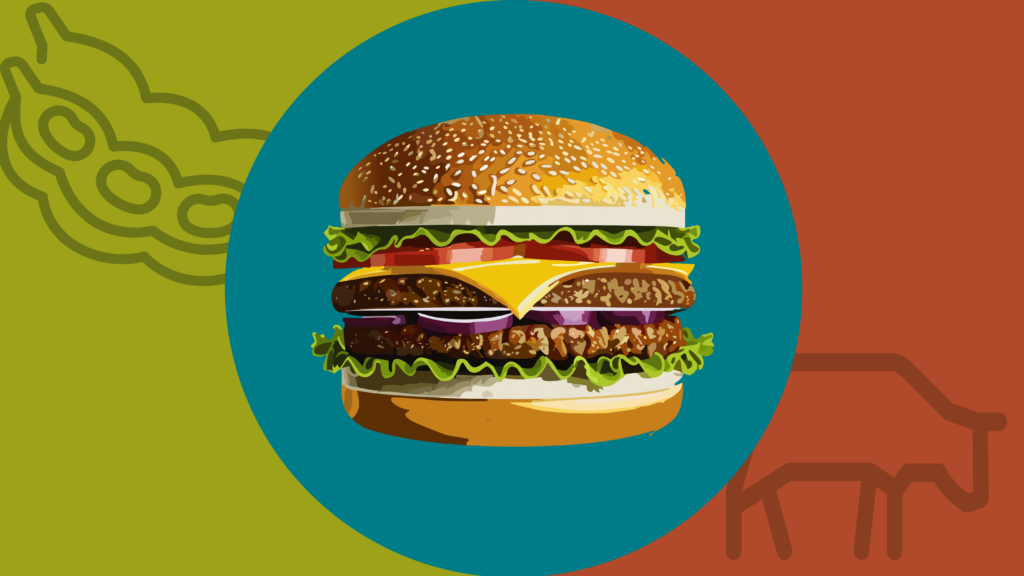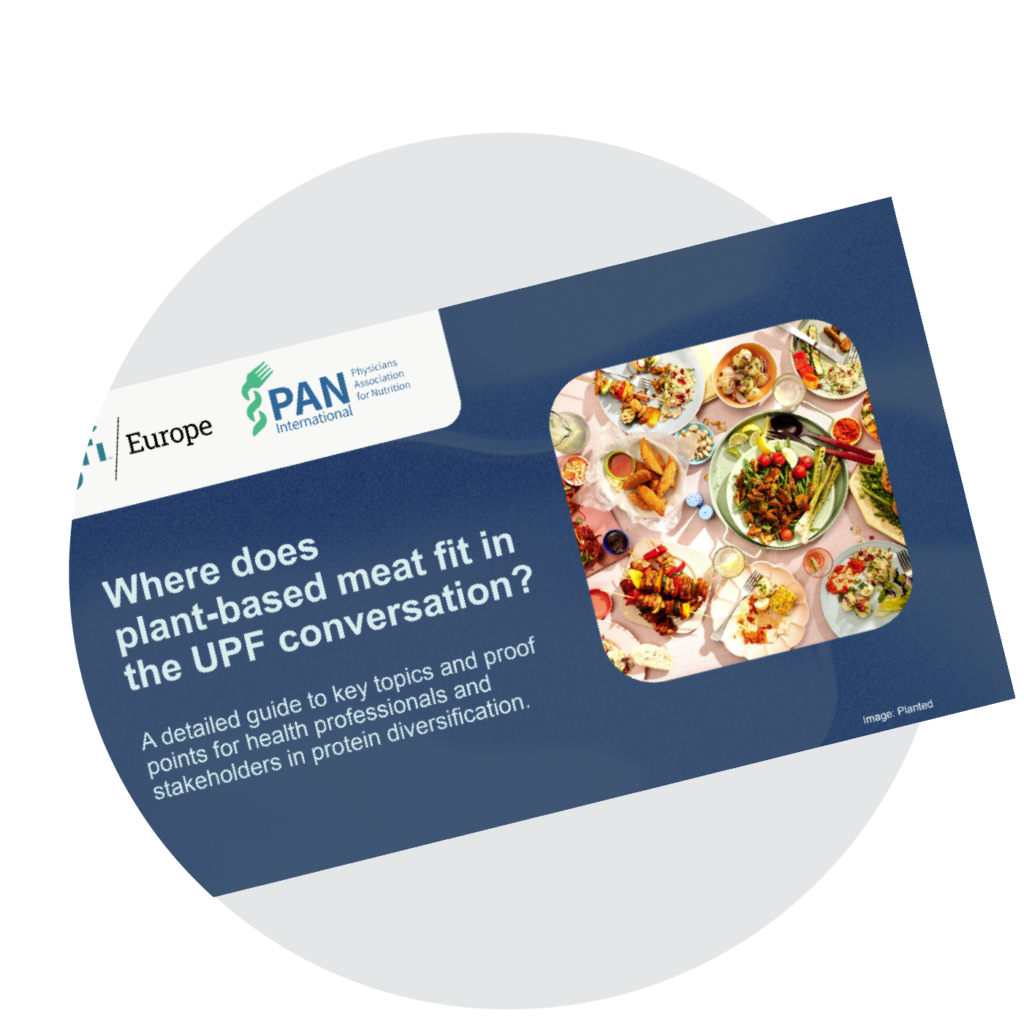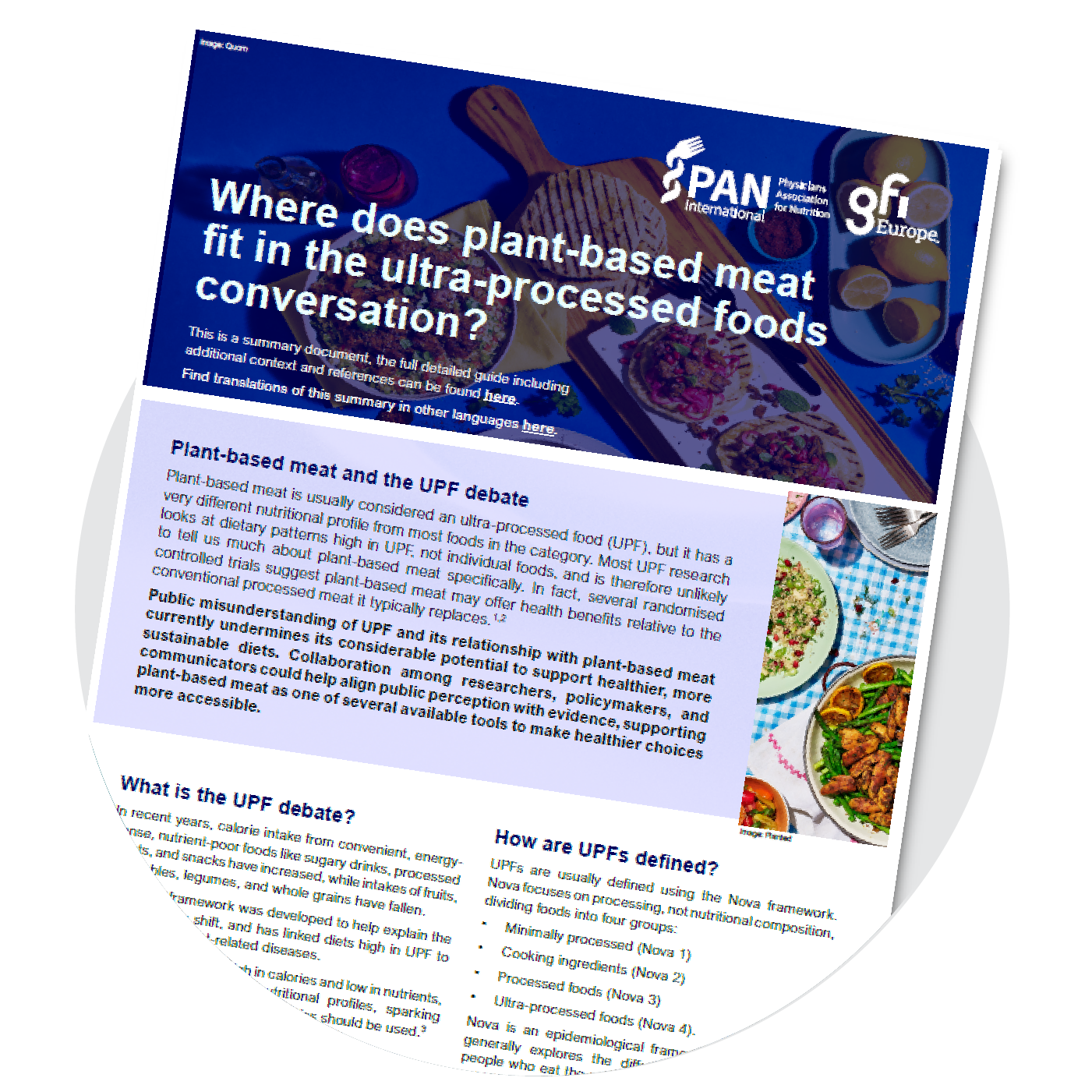Is plant-based meat ultra-processed?
Plant-based meat is one of the product categories consumers most associate with being ultra-processed, but research has also found it could be associated with several health benefits. So what does this mean? We take a look at the science.

Read our in-depth guide on how plant-based meat fits within the UPF discourse
Developed in collaboration with the Physicians Association for Nutrition (PAN) This guide offers a deep dive into the often polarised discussion surrounding ultra-processed foods and plant-based meat, and unpacks the available evidence.

Read the full report

Read the summary
Many people are worried about ultra-processed foods and health, and plant-based meat is one of the product categories consumers most associate with being ultra-processed. However, nutritionally speaking, plant-based meat is very different from many kinds of food in this category: unlike the majority of ultra-processed foods (UPF) it is typically a source of fibre, low in sugar and low in saturated fat. Plant-based meat has also been associated with several health benefits in randomised controlled trials, contrary to findings about UPF as a whole.
So what does this mean for the nutritional profile of plant-based meat? Below is a rundown of the science (as of December 2024) on ultra-processed foods, and how this relates to plant-based meat.
Is plant-based meat ultra-processed?
Plant-based meat is usually considered ultra-processed, but unlike many other foods in the category such as processed meat and sugary drinks, research tends to find it can reduce health risks relative to the conventional meat it replaces.
Just as with conventional meat products, there is a lot of variation in the level of processing different plant-based meat options undergo. Some products available in Europe today fit the Nova 1 ‘minimally processed’ definition, while others fall into the Nova 4 ‘ultra-processed’ category.
But these classifications tell us very little about the nutritional content of these options. In the table below, we compare plant-based meat and processed conventional meat against some of the features most commonly used to describe ultra-processed foods based on averages for these products. From this, it is clear that they do not neatly fit. Plant-based meat is not alone here, and several researchers and nutrition organisations have raised concerns that this categorisation system could unfairly bias people against healthy and accessible foods like wholemeal bread and fortified cereals.

Plant-based meat is rarely mentioned in landmark studies on UPFs, and in studies breaking down impact by food group, UPFs providing a source of fibre, such as wholemeal bread and plant-based meat were associated with reduced health risks. However, a better source of evidence on health impacts of foods is always research looking at that specific food, rather than a large and very varied group like UPF. This is particularly true for plant-based meat.
While more research is needed, studies that do focus on plant-based meat have found that eating it in place of conventional animal meat could:
– Reduce levels of LDL (bad) cholesterol and consequently risk of heart disease, the leading cause of death in Europe.
– Reduce bowel cancer risk, the second leading cause of cancer death in Europe.
– Improve gut health.
– Help maintain a healthy weight.
What proportion of the UPF eaten in key studies were plant-based meat?
The lions share of UPF eaten in these studies were foods like sugary drinks, processed meat, cakes, snacks and biscuits – foods we already know are unhealthy in excess. It is therefore very likely that it is these foods driving the associations seen in UPF trials.
| Study | Proportion of UPFs eaten by study participants that are derived from animal-source foods | Proportion of UPFs eaten by study participants that are plant-based alternatives to animal-source foods |
| Ultra-processed food intake and risk of cardiovascular disease: prospective cohort study (NutriNet-Santé) | Meat, fish and eggs 11%, Dairy products 8% (measured as a proportion of calories). | Not mentioned as a food group |
| Association between consumption of ultra-processed foods and all cause mortality: SUN prospective cohort study | Processed meat 15% (largest single category). Dairy products 12% (measured as a proportion of calories). | Not mentioned as a food group |
| Food processing and cancer risk in Europe: results from the prospective EPIC cohort study | Processed meat 10%, dairy products 12% (measured by weight). | Meat alternatives 0.2%, dairy alternatives 0.9% (measured by weight). |
| Implications of food ultra-processing on cardiovascular risk considering plant origin foods: an analysis of the UK Biobank cohort | Processed meat 3%, dairy products 6% (measured as a proportion of calories). | Meat alternatives 0.2% (measured as a proportion of calories). |
What exactly is an ultra-processed food?
The question of whether a given food is ultra-processed does not have a hard and fast answer. The term ultra-processed is widely used, but not well understood either by experts or the general public. Indeed, a study asking health experts and food industry specialists to categorise foods as ultra-processed or not found only 32-34% agreement.
Processing is a general term, ranging from something as simple as chopping to more complicated processes like fermenting, pasteurising, extruding or distilling. The processing level of foods is usually determined by the Nova classification system, developed by Brazilian researcher Carlos Augusto Monteiro in 2009. Nova is not an acronym, but it is often written in all capitals.
The following is a simplified outline of the Nova category definitions:
- Nova 1: Unprocessed or minimally processed foods. Minimal processing includes the removal of inedible or unwanted parts of a food source. Nothing is added to the original food in this category.
- Nova 2: Processed culinary ingredients. Substances made from group one foods or from nature that are processed for use in cooking. These foods are rarely eaten by themselves.
- Nova 3: Processed foods. Foods from group one that have been processed and/or combined with foods from group two, or group two foods that have been further processed into a final product that is ready to cook or eat.
- Nova 4: Ultra-processed foods. Foods that have been made using a series of processing steps, including the addition of artificial ingredients, which usually contain few or no intact group 1 foods.
You may notice that without the examples of foods often given alongside these definitions, it can be incredibly difficult to place many foodstuffs in a category with certainty. And even for basic foods there is a lot of confusion. Plain yoghurt, for example, is usually categorised as Nova 1, even though it contains ingredients such as lactic acid and it is fermented – aspects that would seem to place it in Nova 3. Likewise, canned chickpeas are placed in Nova 3, the same category as processed meat like sausages and bacon – even though these foods have wildly different nutritional characteristics.
While there are some notable issues with the UPF framework as a strictly scientific nutritional metric, as a socio-political framework it clearly captures an alarming ongoing trend towards decreasing diet quality and increasing diet-related ill health in several countries. In this context, however, plant-based meat represents an opportunity rather than an obstacle. With processed conventional meat thought to be a key driver of the adverse outcomes seen in UPF studies, increasing the availability of tasty, affordable plant-based meat products that represent a simple direct swap could be a key lever to facilitate healthier choices alongside work to promote the greater consumption of plant-based wholefoods.
Not all ultra-processed foods are created equal
As discussed above, the nutritional characteristics of foods within the ultra-processed category vary significantly, meaning studies based on these nebulous definitions risk missing important nuances in what is actually causing the negative outcomes associated with the ultra-processed group as a whole.
A study published in The Lancet breaking down ultra-processed foods by sub-category found that processed meat and sugary drinks drove a significant proportion of the adverse health associations seen in their dataset, with processing levels in other subgroups seeming to have far weaker, if any, association with poor health outcomes. These findings have since been replicated in other studies. A systematic review of several trials which normalised UPF intake to remove the influence of these foods on the category as a whole found that with processed meat and sugary drinks removed, the risk associations with cardiovascular disease and stroke disappeared.
So what does this mean? In simple terms it suggests that processing level in these categories didn’t meaningfully change the risk of eating them: a homemade cake and an ultra-processed cake would carry similar health implications (it’s just much easier to eat a lot of cake if you don’t need to go to the trouble of making it).
The study even found that certain ultra-processed foods such as bread and breakfast cereals were correlated with positive health outcomes, which researchers suggested could be attributed to their high fibre content. This is because other factors within their nutritional make up are likely more important in determining health outcomes than the level of processing.
The health impacts of processed and ultra-processed meat
The conventional meat that plant-based meat often replaces makes up a sizeable chunk of the ultra-processed foods eaten in Europe, and the above-mentioned study was not the only one to identify the specific link between high consumption of processed conventional meat with increased health risks. Studies using the NutriNet Sante and Nurses Health Study one and two cohorts also found these associations.
Importantly, evidence on the harms of red and processed meat is not only derived from broad studies looking at ultra-processed foods. Studies looking solely at red and processed meat offer more reliable evidence, as they are based on more concrete definitions. Systematic reviews have found associations between processed meat and major drivers of diet-related ill health in Europe including heart disease (the largest cause of death in Europe) and diabetes, as well as bowel cancer, (the second most prevalent cancer and the second largest cause of cancer-related death in Europe).
Impact of processing on the nutritional value of plant-based meat
Whole plant foods are undeniably very healthy, and should comprise a significant proportion of a healthy balanced diet, but this does not mean that all processing is inherently bad. Research has found that the way that plant-based meat is made can improve certain aspects of its nutritional profile relative to the raw ingredients, which will likely be of growing importance in the transition towards more plant-based eating patterns.
Bioavailability improvements
The bioavailability of a nutrient describes how easy it is for the body to break down and use. Plant sources of protein can be less bioavailable, but certain processing methods used to make plant-based meats improve this. Research suggests fungi and algae protein sources have equivalent bioavailability to animal sources.
The reason for differences in bioavailability between plant sources of protein and other sources like fungi, algae and animals are so-called ‘anti-nutrients’ – chemicals that plants produce as a defence mechanism to reduce the digestibility of the nutrients within them.
The processing techniques used to make plant-based meat can offer certain advantages compared with their raw ingredients by reducing the presence of these anti-nutrients and enhancing other features that improve bioavailability.
Complete proteins and enhanced amino acid profiles
Proteins are made from building blocks called amino acids. Some of these we can make ourselves, and some we must get from the food we eat (known as ‘essential amino acids’). Not all proteins are created equal – and it is important to ensure that across the protein sources someone eats, all essential amino acids are covered.
Protein from animals and fungi are ‘complete’ – meaning they contain all of the essential amino acids – but this is not always the case in protein from plants.
In humans, there are 20 types of amino acid, 11 of which the body can make itself and nine of which need to come from food. Most plant-based protein sources, such as beans or gluten in bread, are not complete protein sources by themselves. However, many popular simple meals like bean stew with bread combine these, and therefore provide all of the essential amino acids.
However, some plant proteins are complete – and these are often the proteins used as the basis for plant-based meat, soy and quinoa are two examples. Products made from fungi like mycoprotein are also sources of complete protein.
Plant-based meats are also able to use blends of different kinds of protein to achieve an optimal amino acid balance. One example used is the combination of protein from cereals and pulses. Cereals are usually low in lysine while pulses tend to be low in cysteine and methionine – but a combination of wheat and pea protein can provide a complete amino acid profile.
Micronutrients and fortification
At present, the micronutrient profiles of plant-based meats vary a lot, and this is a growing area of focus within the sector. Fortification has been identified as an important opportunity to facilitate the transition towards healthier, more sustainable diets.
Even in Europe, deficiencies in certain nutrients are surprisingly common. While many of these stem from not eating enough fruits, nuts and vegetables, as diets become increasingly plant-based, more attention may need to be paid to those nutrients that are currently provided primarily by animal products, such as iron, iodine zinc and B12. Like with protein, the bioavailability of nutrients is an important consideration in plant-based foods.
Plant-based meat options with very good micronutrient bioavailability are already available, such as those made from mycoprotein, and research is also ongoing to further improve ingredients made from plants. Progress has been made already, with some plant-based products such as the Impossible burger (not yet available in Europe) containing plant sources of iron with equal bioavailability to that of conventional meat.
Doesn’t plant-based meat have lots of ingredients and additives?
Most of the food in supermarkets, including both conventional and plant-based meat products, contain additives. All food additives used in Europe must meet stringent food safety criteria, requiring a large body of high-quality evidence in order to be approved for use. However, recently some concerns have arisen that certain additives may have previously undiscovered effects.
Preservatives, emulsifiers, gelling agents, thickeners and sweeteners are some key groups that are often discussed in these contexts.
Preservatives
Preservatives are important for improving shelf life and reducing food waste. Salt is a simple preservative but other ingredients are also used for this purpose. Recent research has found that added nitrates, nitrites and nitrosamines, which are most commonly used in processed conventional meat products, may be linked with increased cancer risk.
Emulsifiers
Emulsifiers are the most commonly used additive group in all foods. In plant-based meat, they are used to create a juicy meat-like texture. Emulsifiers are found naturally in many whole foods such as eggs, seeds and legumes, and also frequently made within the body.
Research has suggested emulsifiers may contribute to some of the negative health correlations seen in studies on ultra-processed foods, but the evidence underpinning these claims has been subject to substantial expert criticism, and is far less comprehensive than the available data on individual ingredients required for approval.
Some of the most common emulsifiers discussed and/or used in plant-based meat, and the research into their specific health impacts, are as follows:
- Xanthan gum: As a long-standing and frequently used emulsifier, Xanthan Gum has been explored in a variety of high-quality randomised controlled trials and follow-up real-world studies. A report compiled for the European Commission and published in 2017 found Xanthan gum to be very safe, with no notable adverse effects even in the highest exposure studies. This was found to be true across all age groups including children and infants.
- Plant-based lecithins: These are a well-established group of emulsifiers for which extensive health evidence is available from both randomised controlled trials and real-world data. Again, a review conducted for the European Commission and published in 2017 found them to be very safe, with no adverse effects noted even in the highest exposure studies. Allergenicity for those with a soy allergy was the main identified risk. Several preliminary studies have also identified potential health benefits of soy lecithin including lowering blood pressure, and reducing cholesterol, although these effects are debated.
- Methylcellulose and hydroxypropyl methylcellulose: These are well-researched and understood emulsifiers (also used for some other useful properties like gelling) with well established safety profiles validated by the European Food Safety Authority (EFSA). The EFSA’s systematic review of trial data found hydroxypropyl methylcellulose could help blood sugar management and reduce cholesterol in sufficient quantities.
- Plant protein isolates: Potato and fava bean proteins are commonly used as emulsifiers in plant-based meat. There are no noted health concerns associated with them, and preliminary studies have suggested they could be beneficial for slowing the rate of digestion and improving glycaemic control in foods.
Sweeteners
Since plant-based meats are savoury products, sweeteners are rarely used in them. As an additive group, the health effects associated with artificial sweeteners have not been conclusively proven. A systematic review published by the World Health Organisation in 2022 found non-sugar sweeteners may have small short-term impacts on glucose metabolism and result in lower body weight when coupled with calorie restriction. However, it found no clear consensus on their long-term impact on weight loss or maintenance, and therefore recommended against using them for weight management.
So what does this mean for plant-based meat?
On the whole, evidence suggests that whether a plant-based meat product does or does not fall into the ultra-processed food category has little bearing on how healthy it is, and in fact, certain processing steps have been found to increase their nutritional value by adding or improving the bioavailability of important nutrients.
These studies do show that processed conventional meat specifically, alongside sugary drinks, is a primary driver of negative health outcomes seen in UPF studies, supporting the argument that plant-based meat could present an opportunity for public health as an easy way to reduce their overconsumption of processed conventional meat to recommended levels.
For more on this topic, explore this report from Churchill Fellowship researcher Jenny Chapman on the topic of ultra-processing and how it relates to plant-based meat.

Plant-based meat and health
Learn more about the topic of plant-based meat more broadly, including the latest news and additional resources.
